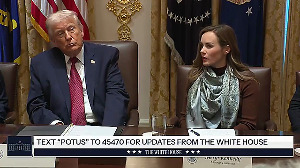Brands names are always critical, but -- as Ambi Parameswaran has discovered -- finding the right one for the Indian consumer requires something special.
Illustration: Uttam Ghosh/Rediff.com

"What a strange name," was our first reaction.
I was with my client, a leading confectionery marketer based in south India and we were discussing the launch of a new brand by the global confectionery major Perfetti. The brand: Alpenliebe.
The brand used a till then less used technical process known as "deposit candy" and tasted better than most other popular candies. But we were wondering why the company had adopted such a tongue-twister of a name.
We need not have worried.
A few weeks later when speaking with a person, who was once a young brand manager working on the launch of the blockbuster brand Fair & Lovely, I discovered the art of brand name transmogrification by Indian consumers.
I was asking him whether the company felt the brand name was a little too complicated for the middle-class Indian woman. He explained how Indian consumers manage to create their own versions of a tough-to-pronounce brand name. So in many parts of the country, especially in north India where it was a large seller, Fair and Lovely was simply known as "Lovely".
I had the answer to my Alpenliebe problem.
Indian consumers and kids soon figured out a suitable abbreviation and the brand went on to become the biggest in the hard-boiled confectionery space. Really makes you wonder whether a brand name matters when the product quality is superb.
That aside, Indian consumers do manage to figure out a variation of a long brand name.
In the larger scheme of things, do brand names matter and what purpose do they serve?
The valuation guru, Aswath Damodaran of NYU Stern School of Business, speaking at an Innovation Forum, said: "If you as a company tell me that you have a brand name, I'm going to ask you a question: Do you have the power to charge a higher price for the same product? If your answer is 'no', I don't think you have a brand. You may think you do, but I don't think your brand has any value."
I wonder what Damodaran's view would be on the value of brands in their Indian-style, truncated avatars.
Brands names are indeed critical.
In a fascinating article in The New Yorker, James Surowiecki [author of the very readable The Wisdom of Crowds] goes behind the way brand names in themselves can connote meanings. He says that the "phonemes" [sounds] in a brand name can independently connote a meaning.
In ancient Greece, a philosopher called Hermogenes argued that the relationship between a word and its meaning is purely arbitrary; Cratylus, another philosopher, disagreed. It was finally left to the one and only Socrates, who concluded that there is a connection, sometimes.
Surowiecki points towards how the use of vowel sounds in the beginning of a name may give a different meaning, compared to a vowel at the end of a name.
Front vowels like "I" in, say, "min" gives an image of lightness and smallness, while back vowels like "a", evoke heaviness and bigness. Similarly, some consonants can sound heavy, while some like "s" and "z", known as fricatives, can sound lighter.
No wonder when Cialis was visualised as a [long acting, romantic] competition to Viagra, and it picked phonemes that had a softer audio feel.
In India, too, companies have done interesting experiments with brand names.
I remember Shingar cosmetics launching their nail enamel and calling it Tips & Toes; the brand name immediately cued fingertips and toes to a middle-class girl, who was probably going to use a nail enamel for the first time in her life.
However, when they decided to name their lipstick brand Kiss & Tell it failed to find takers. There could have been a different dynamic in operation as I will explain in a bit.
When Emami launched its male fairness cream, it picked Fair & Handsome as the name, to cue a male benefit distinct from the feminine "lovely" epithet.
Companies when launching new brands in India have figured out how to navigate the choppy waters of the cacophonic Indian marketplace.
Here are three more tests to subject brand names to:
First, the brand name chosen needs to be a non-taboo name in all the 15+ languages listed on a rupee note. If this is a problem, you need to figure out how to spell the brand in a suitable way in the "problem" language.
Second, you need to know how the brand will play out in general trade. Coming back to the failed lipstick, can you imagine a young girl asking a retailer for Kiss & Tell? What will his response be? So, a brand that may play well in modern trade, may be a disaster in general trade, where there is a shopkeeper coming in the middle. I wonder how the brand name Love It was chosen for a chocolate, given the shopkeeper issue.
Third, brands will get transmogrified in India. So, for a moment visualise the ways your lovingly crafted brand name will be handled in the market. The tail, the middle and the head.
I was given a rude reminder of this effect when at an airport bookshop I asked the shop-in-charge how my book Nawabs Nudes Noodles was doing. To which he called out to his assistant loudly, "Arre Noodles ka author aya hai. Un ko book display dikhao."
Fortunately for me the book is not titled "Nawabs Noodles Nudes"!
Ambi Parameswaran is a brand strategist and founder, Brand-Building.com. He can be reached at ambimgp@brand-building.com.











